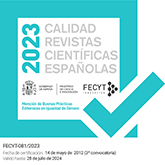Dehumanized Mothers: the Invisibility of Cuban Wet Nurses
DOI:
https://doi.org/10.3989/aeamer.2023.2.04Keywords:
Visual Culture, Slavery, Wet Nurses, Maternity, CubaAbstract
This paper analyses the image of wet nurses in Cuba, based on the imaginary that have come down to us having the Cuban wet nurse as their main topic. On the one hand, we analyse the few images of Cuban wet nurses on canvas and pictures from 19th century and, on the other hand, some postcards from the beginning of 20th century. Through this analysis, we demonstrate the process of cancellation and dehumanization suffered by wet nurses, usually Afro-descendants, in Atlantic slave-owning societies such as the Cuban region.
Downloads
References
Barcia, Carmen, Oficios de mujer. Parteras, nodrizas y amigas: servicios públicos en espacios privados, Santiago de Cuba, Editorial Oriente, 2015.
Beckles, Hilary, Centering Woman:Gender Discourses in Caribbean Slave Society, Princeton, M. Wiener, 1999.
Bolufer Peruga, Mónica, «Actitudes y discursos sobre la maternidad en la España del siglo XVIII. La cuestión de la lactancia», Historia social, 14, Valencia, 1992, 3-24.
Bush, Barbara, Slave Women in Caribbean Society, 1650-1838, Bloomington, Indiana University Press, 1990.
Camacho, Jorge, «Las nodrizas africanas», en Camacho, Jorge, Miedo negro, poder blanco en la Cuba colonial, Frankfurt/Madrid, Vervuert Verlagsgesellschaft, 2015, 83-112. https://doi.org/10.31819/9783954878284-004
Cleveland, Kimberly, Black Women Slaves Who Nourished A Nation: Artistic Renderings of Wet Nurses in Brazil, Nueva York, Cambria Press, 2019.
Cowlling, Camillia, Conceiving Freedom: Women of Color, Gender, and the Abolition of Slavery in Havana and Rio de Janeiro, Chapel Hill, University of North Carolina Press, 2013. https://doi.org/10.5149/9781469610894_Cowling
Day, Nicholas, Baby Meets World: Suck, Smile, Touch, Toddle: A Journey Through Infancy, Nueva York, St. Martin's Publishing Group, 2013.
Fauve-Chamoux, Antoinette, «Breast Milk and artificial Infant Feeding», en The Cambridge World History of Food, Cambridge, Cambridge University Press, 2000, 626-635. https://doi.org/10.1017/CHOL9780521402149.072
Fernández Soneira, Teresa, La bella cubana. Rostros de mujeres en la Cuba del siglo XIX, Miami, Alexandria Library, 2022.
Fildes, Valerie A., Wet Nursing: A History from Antiquity to the Present, Oxford, Basil Blackwell, 1988.
Finch, Aiska K. «Scandalous Scarcities: Black Slave Women, Plantation Domesticity, and Travel Writing in Nineteenth-Century Cuba», Journal of Historical Sociology, 23:1, Teherán, 2010, 101-143. https://doi.org/10.1111/j.1467-6443.2009.01361.x
Franklin, Sarah L., Women and Slavery in Nineteenth-Century Colonial Cuba, Rochester, University of Rochester Press, 2012. https://doi.org/10.1515/9781580467773
Guanche, Jesús, Iconografía de africanos y descendientes en Cuba, La Habana, Fundación Fernando Ortiz, 2008.
Guillemeau, Jacques, De la Grossese et accouchement des femmes du gouvernement de celles ci et moyen de survenir aux accidents qui leur arrivent, ensemble de la nourriture des enfans, París, A. Pacard, 1621.
Hall, Gwendolyn, Social Control in Slave Plantation Societies: A Comparison of St. Domingue and Cuba, Baltimore, Maryland/Londres, Johns Hopkins Press, 1971.
Hicks, Anasa, Hierarchies at Home: Domestic Service in Cuba from Abolition to Revolution, Nueva York, University ProQuest Dissertations Publishing, 2017.
Knight, Franklin W., Slave Society in Cuba during the Nineteenth Century, Madison, Milwaukee/Londres, University of Wisconsin Press, 1970.
Mena, Luz M., «Raza, género y espacio: las mujeres negras y mulatas negocian su lugar en La Habana durante la década de 1830», Revista de estudios sociales, 26, Bogotá, 2007, 73-85. https://doi.org/10.7440/res26.2007.05
Morrissey, Marietta, Slave Women in the New World: Gender Stratification in the Caribbean, Lawrence, University Press of Kansas, 1989. https://doi.org/10.17161/1808.32447
Naranjo, Juan, Fotografía, antropología y colonialismo (1845-2006), Madrid, Gustavo Gili, 2006.
Naranjo Orovio, Consuelo, «De la esclavitud a la criminalización de un grupo: la población de color en Cuba», Revista del Centro de Investigaciones Históricas, 16, Madrid, 2005, 137-178. https://doi.org/10.4000/nuevomundo.2019
Orozco, María Elena y Sanz Pérez, Etna Cecilia, «El esclavo imaginado hoy en las artes visuales en el oriente de Cuba», Études caribéennes, 4, Pointe-à-Pitre, 2021.
Osborn, M. S., «The rent breasts: A brief history of wet-nursing», Midwife, Health Visitor & Community Nurse, 15:8, Evanston, IL., 1979a, 302-306.
Osborn, M. S., «The rent breasts. Part II», Midwife, Health Visitor & Community Nurse, 15:9, Evanston, IL., 1979b, 347-348.
Papastavrou, M.; Genitsaridi, SM.; Komodiki, E.; Paliatsou, S.; Kontogeorgou, A. y Iacovidou, N., «Breastfeeding in the course of history», Journal of Pediatrics & Neonatal Care, 2:6, Oklahoma City, 2015, 1-9. https://doi.org/10.15406/jpnc.2015.02.00096
Pollet, Camille, «Le lait et la vertu. Définir la "nourriture" de la petite enfance dans les traités français et anglais sur la noblesse au XVIIe siècle», Histoire culturelle de l'Europe, 2, 2018. Disponible en: http://www.unicaen.fr/mrsh/hce/index.php?id=508 [Acceso: 04/02/2023].
Pöppel, Hubert, «El seno desnudo de María. La Virgen de la leche en el arte del Siglo de Oro español», en Hiergeist, Teresa y Olmo, Ismael del, Discourses of the Holy and the Sacred from the 15th to the 17th Century, Berlín, Peter Lang, 2020, 173-195.
Provencio, Lucía, «Las madres cubanas no son madres sino a medias. Discurso teórico y disciplina de la maternidad (Siglo XIX)», en Chacón, Francisco (coord.), Dimensiones del diálogo americano contemporáneo sobre la familia en la época colonial, Murcia, Universidad de Murcia/Editum, 2009, 321-368.
Provencio, Lucía, «La trampa discursiva del elogio a la maternidad cubana del siglo XIX», Americanía, 1, Sevilla, 2011, 42-73.
Ramírez Chicharro, Manuel, «Doblemente sometidas: las "mujeres de color" en la república de Cuba (1902-1959)», Revista de Indias, 262, Madrid, 2014, 783-828. https://doi.org/10.3989/revindias.2014.026
Romay, Tomás, Memoria sobre la introducción y progresos de la vacuna en la Isla de Cuba, La Habana, Imprenta de la Capitanía general, 1805.
Rubiera Cancelas, Carla, «El uso de las esclavas como nodrizas en la Roma antigua. Más allá de la figura simbólica», Dialogues d'histoire ancienne, 19, Franche-Comté, 2019, 205-220. https://doi.org/10.3917/dha.hs19.0205
Rubiera Castillo, Daisy, «Apuntes sobre la mujer negra cubana», Cuban Studies, 42, Pittsburgh, 2011, 176-185. https://doi.org/10.1353/cub.2011.0006
Sagra y Peris, Ramón de la, Historia física, política y natural de la isla de Cuba, Tomo III, Paris, Libreria de Arthus Bertrand, 1839-1845. https://doi.org/10.5962/bhl.title.207
Stevens, Emily; Patrick, Thelma y Pickler, Rita, «A History of Infant Feeding», The Journal of Perinatal Education, 18:2, New Jersey, 2009, 32-39. https://doi.org/10.1624/105812409X426314 PMid:20190854 PMCid:PMC2684040
Stolcke, Verena, Racismo y sexualidad en la Cuba colonial, Madrid, Alianza, 1992.
Torre, José María de la, Lo que fuimos y lo que somos, o, La Habana antigua y moderna, La Habana, Ediciones Históricas Cubanas, 1857.
Vasconcellos, Christianne Silva, «Fotografías de amas de leche en Bahía. Evidencia visual de los aportes africanos a la familia esclavista en Brasil», Nómadas, Madrid, 35, 2011, 119-138.
Wickes, Ian G., «A History of Infant Feeding», Archives of Disease in Childhood, 28, Londres, 1953, 416-422. https://doi.org/10.1136/adc.28.141.416 PMid:13105394 PMCid:PMC1988630
Downloads
Published
How to Cite
Issue
Section
License
Copyright (c) 2024 Consejo Superior de Investigaciones Científicas (CSIC)

This work is licensed under a Creative Commons Attribution 4.0 International License.
© CSIC. Manuscripts published in both the printed and online versions of this Journal are the property of Consejo Superior de Investigaciones Científicas, and quoting this source is a requirement for any partial or full reproduction.All contents of this electronic edition, except where otherwise noted, are distributed under a “Creative Commons Attribution 4.0 International” (CC BY 4.0) License. You may read here the basic information and the legal text of the license. The indication of the CC BY 4.0 License must be expressly stated in this way when necessary.
Self-archiving in repositories, personal webpages or similar, of any version other than the published by the Editor, is not allowed.
Funding data
Ministerio de Ciencia e Innovación
Grant numbers 1ID2020-112730GB-I00
Agencia Estatal de Investigación
Grant numbers PID2020-112730GB-I00















